Fire & Safety Solutions
CALL OUR TEAM NOW 0800 612 6537
Also FREE from UK mobiles
Free Delivery
on 100s of Products
Secure Payments
with our fast checkout
Online Support
Contact Us Now
30 Day Accounts
for Public Sector
5 Star Customer Feedback
Fire Door Buying Guide
What is a fire door?
A fire door is made up of a door leaf, door frame, fixtures and fittings and is a specialist door with a fire-resistance rating. Fire doors form part of a passive fire protection system within a building to reduce the spread of fire and smoke.
The Architectural and Specialist Door Manufacturers Association (ASDMA) defines a fire door as: "A complete installed door assembly comprising doorframe, door leaves, other panels, hardware, seals and any glazing that, when closed, is intended to resist the passage of fire and smoke in accordance with specified performance criteria. A fire door = a complete installed assembly."
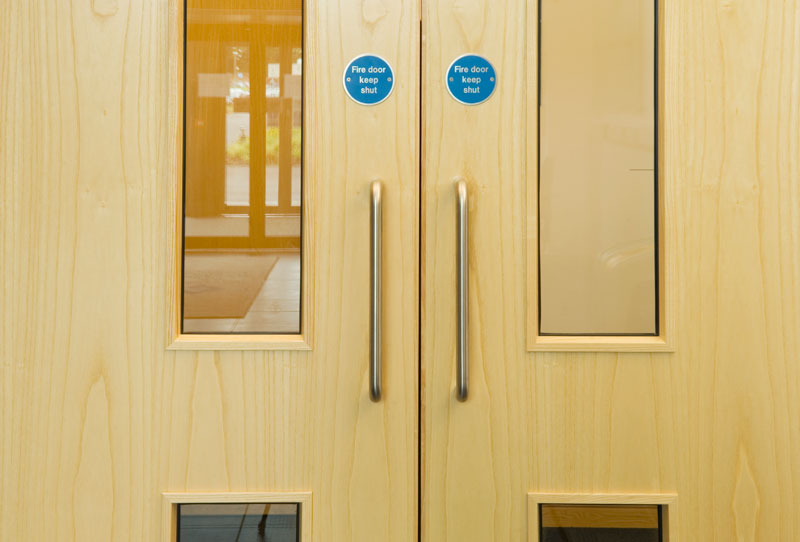
The parts of a fire door assembly
Fire door assemblies, or fire door sets as they are also known comprise a number of parts and accessories. Ideally, a fire door would be bought together with its frame and fittings to ensure the complete set is fit for purpose.
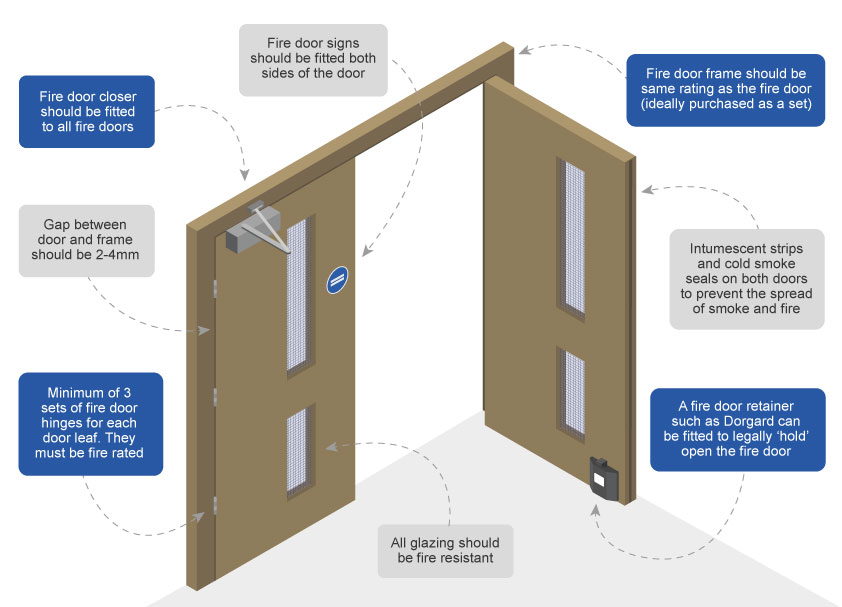
Fire door leaf
The fire door leaf (the actual 'door') is typically made of solid timber or composite lightweight materials. Fire doors are tested for their fire rating and are usually FD30 (can resist fire for up to 30 minutes) or FD60 (can resist fire for up to 60 minutes). Fire doors can be plain or panelled, with a range of finishes. If glazing is required, this has to be done with fire resistant glass. Fire doors can be a standard size or may need to be made to measure.
Fire door frame and seals
The fire door frame, which the manufacturer has tested together with a fire door leaf must also offer the same fire protection as the leaf, e.g. 30 or 60 minutes. To stop the fire spreading, an intumescent fire door seal is fitted around the sides and top of fire doors or frames. The fire door seal (also called an intumescent seal) will swell rapidly when exposed to the heat of a fire and close off the gap between door and frame.
Smoke is a major cause of death and injury in a fire. It is therefore sometimes necessary, especially when protecting an escape route, to provide additional protection against smoke spreading through the gaps around the fire door. In these cases, the fire doors are specified with the letter ‘s’, e.g. FD30s. These fire doors require fire and smoke seals with integrated bristles.
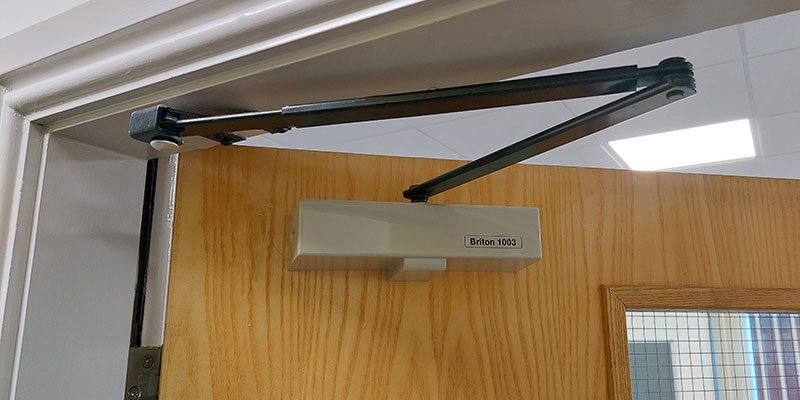
Fire door hardware
All fire door hardware (locks, latches, hinges, etc.) must have the same fire rating as the fire door. A fire door leaf should always be fitted with a minimum of 3 sets of fire rated hinges. A fire door must also have an automatic closing device. Self-closing devices ensure that any fire door shuts, and latches after use so that if a fire breaks out, the door is closed and can prevent the spread of smoke and fire.
Fire door retainers
Internal fire doors should never be propped or wedged open as this stops the fire door from closing and doing its job in the event of a fire. Propping fire doors open is illegal and could result in the responsible person facing prosecution. They could get a heavy fine and a custodial sentence. Fire door retainers and free-swing fire door closers are legal solutions to holding fire doors open. They allow good air circulation and easy movement for people within a building. These types of devices will hold a fire door open safely under normal circumstances but will automatically release the door when the fire alarm sounds, allowing the door closer to close the door.
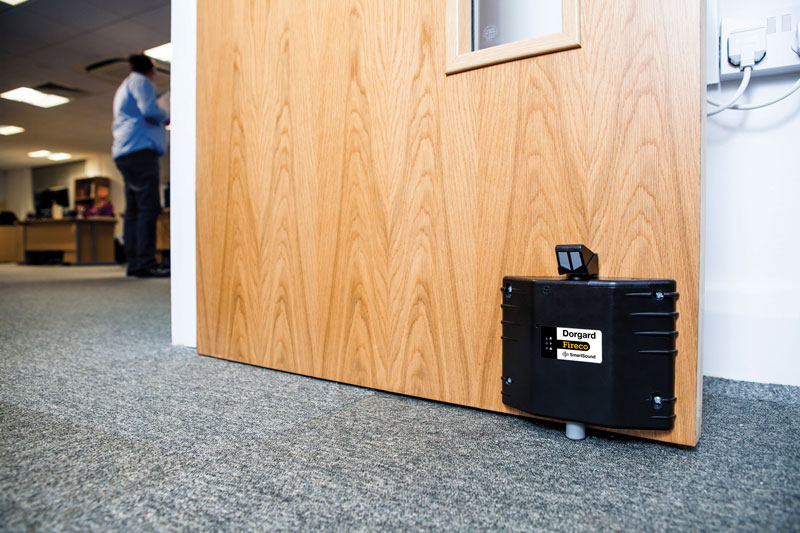
Fire door signage
A fire door must be identified by displaying fire door signage on both sides of the door. When a fire door is held open by a door retainers or free-swing fire door closers, a different sign will be required, for example "Keep fire door open safely". For restricted access areas that are not usually populated, such as storage cupboards and boiler rooms, and which have no self-closing device fitted, "Fire door keep locked" indicates that the door must be kept shut and locked at all times.
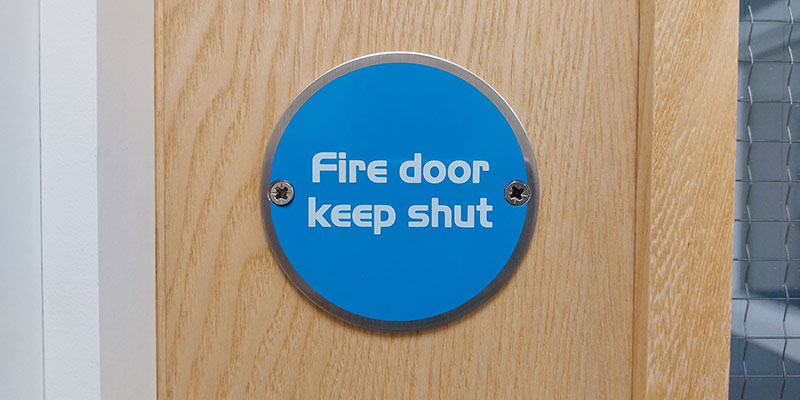
What is the purpose of a fire door?
Fire doors form part of a buildings passive fire protection system. Fire doors help to:
- Reduce the risk of fire and smoke spreading
- Compartmentalise the fire
- Protect an escape route through the building to allow people to get out safely
Fire compartmentalisation
Fire compartmentation is an important part of fire safety in a building. The aim of fire compartmentation is to divide larger spaces into more manageable smaller spaces where fire can be contained should it occur. Fire doors are part of that system and form barriers which compartmentalises the fire, restricting it to a given area. This prevents fire from spreading and protects escape routes such as corridors.
Where are fire doors needed?
Current require the Responsible Person in any organisation, business or HMO to carry out a fire risk assessment. The location of fire doors and the required rating of those fire doors will be set out by the risk assessment.
Some domestic properties also require fire doors. Building regulations detail where fire doors should be used in houses and flats. Most commonly, loft conversions and integral garages require a fire door. For flats, a front door that opens out into a communal corridor is required to be a fire door.
How long will a fire door contain a fire?
Fire doors are usually certified to hold back fire for 30 minutes (FD30) or 60 minutes (FD60). Read our guide to fire door ratings to find out more.
How long do fire doors last?
The condition of a fire door will deteriorate over time and regular maintenance is essential to ensure the door, frame and accessories are in good working order. Assess the condition of your fire door using our fire door checker and maintenance guide.
Considerations when buying a fire door
Certified fire doors
To be certain that a fire door is fit for purpose, it is important to buy certified fire doors. Third-party certification schemes provide evidence that the door has been rigorously tested and complies with regulations. Safelincs fire doors are BWF-Certifire certified and feature certification labels with unique numbers that allow the fire door certificate and specification to be sourced at a later date.
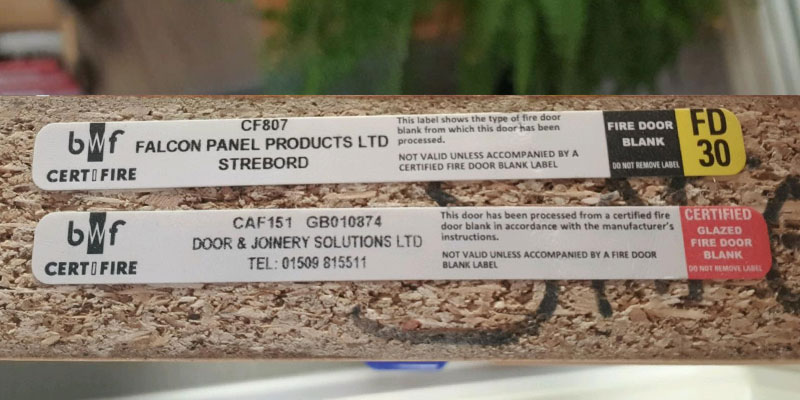
Choosing a finish for your fire door
Safelincs fire doors are now available in a wide range of colours and finishes. Choose from wood veneers, pre-finished paint finishes or even coloured Formica. Fully customise your fire door to fit with your design using our custom fire door builder.
Fire door size
There are a number of different sizes of standard fire doors. If the fire door you require is not a standard size, fire doors can be made-to-measure. See how to measure a fire door or how to measure a fire door with frame for more information about what measurements we require to make a custom size door.
Surface mounted and rebated seals
When purchasing a Safelincs fire door, you can choose to add rebated intumescent seals. This means the manufacturer will pre-cut the rebate around the edge of the door leaf and supply the appropriate fire and smoke seals. If your door does not have a rebate for fire and smoke seals, you can purchase surface mounted intumescent seals. Surface mounted fire door seals are easy to fit retrospectively to fire doors without a rebate as they have a self-adhesive backing that can be fixed to the fire door leaf or frame.
What EN Power Size does my door closer need?
Small and light weight fire doors require less strength from a fire door closer to shut properly in comparison to large and heavy fire doors. When selecting a fire door closer for your fire door you need to find out which door closer has enough closing strength/closing force for your specific door. To make this process easier, door closers have been grouped into different strength categories, called "EN power sizes". Below is the table that shows for each power size how heavy or wide the fire door can be to be safely shut.
If width and weight do not call for the same power size, select the higher power size as the specification needed for your door closer. To find out how much a fire door weighs, use our fire door weight calculator.
Please note: power size EN3 is the minimum required for fire doors that must be fitted with an automatic door closer; EN1 and EN2 are not actually suitable for use on fire doors in accordance with EN 1154.
| EN Closing Force Category | Maximum Door Width | Maximum Door Weight |
|---|---|---|
| EN 1 | 750mm | 20kg |
| EN 2 | 850mm | 40kg |
| EN 3 | 950mm | 60kg |
| EN 4 | 1100mm | 80kg |
| EN 5 | 1250mm | 100kg |
| EN 6 | 1400mm | 120kg |
| EN 7 | 1600mm | 160kg |
Who can fit a fire door?
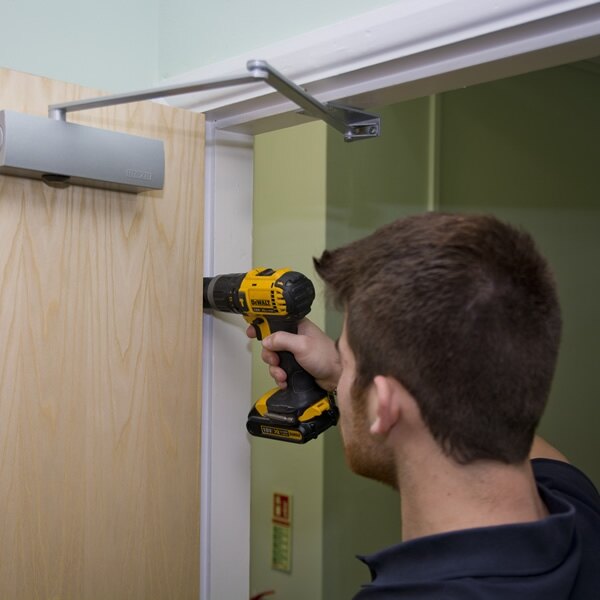
The ASDMA definition of a fire door as a "complete installed assembly" highlights the fact that the installation and maintenance of a fire door set is as important as its construction.
Although a competent professional can install a fire door, it is recommended that the work be carried out by a member of the Accredited Fire Door Installers Scheme. Developed by the BWF in association with FIRAS, the purpose of this scheme is to ensure that fire door installations are carried out correctly, safely and in compliance with current Building Regulations.
FAQs
Which fire door do I need?
To find out which fire door you need, the Responsible Person in any business or organisation should carry out a risk assessment. This will determine where fire doors are required and what fire rating they should have.
In domestic properties, check the Building Regulations for guidance on where to fit fire doors in new-builds or renovations.
Which fire doors require smoke seals?
Typically fire doors protecting escape routes may be required to have smoke seals to control the spread of smoke.Your risk assessment should detail which fire doors are required to have smoke brushes in addition to a standard intumescent fire door seal. Any door requiring a smoke seal will be listed with an ‘S’ following the rating. For example FD30s.Why are fire doors heavy?
Fire doors are typically thicker than standard doors and doors with a solid construction will be particularly heavy. The self-closing device and the force with which the door closes can also make a fire door appear heavy and cumbersome. A free-swing closer can alleviate this issue, allowing the door to swing freely on its hinges as a standard door would. Free-swing door closers ‘take the weight’ out of fire doors in usual operation but will automatically close the door when the fire alarm sounds. This means they are a safe and legal solution to the problem of heavy fire doors.Can fire doors be left open for covid 19?
A safe and legal solution to holding open fire doors is to install a Fire Door Holder also known as a retainer. Fire door retainers can be easily installed onto existing doors and allow the door to be held open at any angle. They comply with regulations because when the fire alarm sounds, the door retainer releases the fire door to close, preventing the spread of fire. Fire doors should never be propped or wedged open to improve ventilation. When held open in this way the fire door will not be able to close in the event of a fire.
Can fire doors be cut to size?
There is no specific advice on how much a fire door can be trimmed. Cutting a fire door to size should only be done after consultation with the manufacturer. The amount that can be trimmed or whether it can be trimmed at all will depend on the construction of the door. It may be possible to trim a fire door with a solid construction. But, more modern lightweight fire doors are often designed to have a higher resistance on the edges or lippings and so trimming these might impact the overall performance of the door and invalidate the certification. For peace of mind, it is advisable to purchase a made-to-measure fire door in these situations.
Which fire door hold open device should I choose?
Fire doors can be held open legally and safely by fitting a fire door retainer or free-swing door closer. Read further guidance on choosing a fire door retainer to discover which one is best for your circumstances.
Reviewed: 29/03/2022 (doc:565 V1.0). Our articles are reviewed regularly. However, any changes made to standards or legislation following the review date will not have been considered. Please note that we provide abridged, easy-to-understand guidance. To make detailed decisions about your fire safety provisions, you might require further advice or need to consult the full standards and legislation.




















